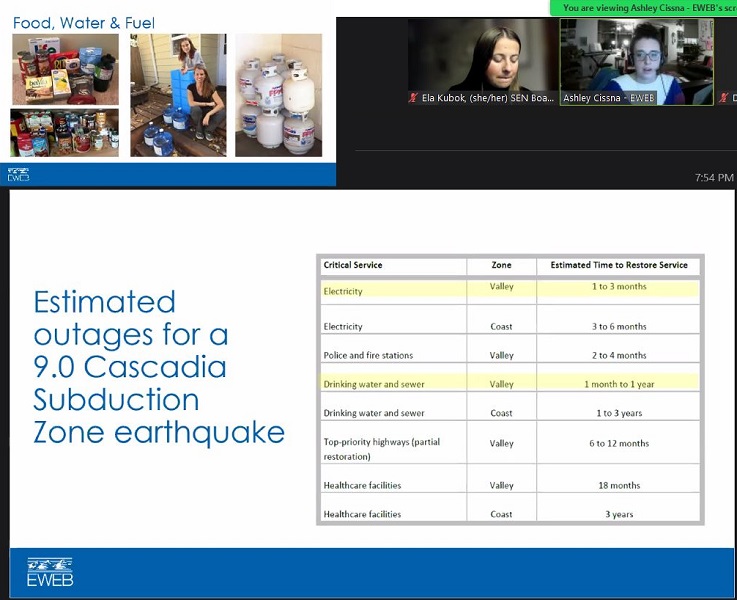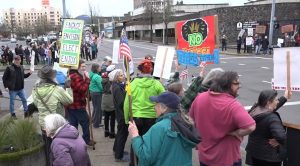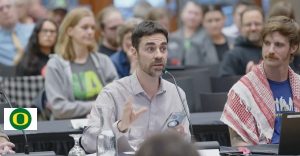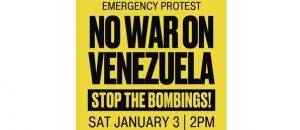EWEB: We may not have drinking water for a year after a 9.0 quake
6 min read
EWEB tells citizens it could be a year before water and sewer service is restored after the Cascadia Subduction Zone earthquake.
Ashley Cissna: We could be without electric service for one to three months and drinking water for one month to a year.
[00:00:05] John Q: That’s Ashley Cissna from EWEB, setting expectations now so that citizens can prepare. Day-to-day living will be very different here after a 9.0 earthquake.
[00:00:15] Ashley Cissna: I’m really glad to be here today to share our Pledge to Prepare program with you.
Thank you for supporting
local citizen journalism
[00:00:19] For those who aren’t familiar with Pledge to Prepare, it is a year-long program that EWEB started in, I want to say 2019, but my years are running together, to get community members to be Two Weeks Ready in the event of an emergency power or water outage. The Two Weeks Ready comes from the Oregon Department of Emergency Management.
[00:00:38] And the reason for that is, what a lot of people talk about is the big earthquake. We all heard about where we’re going to be out of service for a while. The Holiday Farm Fire was a big one that came up recently. Windstorms though we had that just here in December. Several thousand residents were out of power just for 24 hours, so that a big incident. But then the snowstorm just a week before, that people were out of power for four or five days. So it can definitely be something smaller than an earthquake that you still might want to be prepared for.
[00:01:07] A lot of people, with the Holiday Farm Fire they might not have been aware of was that the fire did get really close to EWEB’s water filtration center over in Springfield. And if that had happened, we might’ve had power, but our water might’ve been affected for awhile. So just something that we want to be prepared for, at all different levels.
[00:01:25] So what does Two Weeks Ready look like? The things that are most obvious are food, water, and fuel. You’re going to want to get nonperishable food items. Canned goods are great. Beef jerky, nuts, seeds, dried fruit. Somebody recommended you always get something that you enjoy eating. You don’t want to be stuck eating tunafish for a week, if that’s your least favorite food. So flip some stuff in there that, or find little treats and I personally picked trail mix with M&M’s in there. Cause that’s a treat I don’t usually allow myself.
[00:01:56] Another tip that some people forget is to put a can opener in there. Cause you’d hate to have all your cans and not be able to eat them.
[00:02:02] Water. You need to get one gallon per person per day. So that’s 14 gallons for two weeks for each individual. You’re going to want extra if you have pets, so plan for them. That can get tricky to store if you have a house, a smaller square footage.
[00:02:16] The other last obvious one is a fuel source. I have a camping stove, so I’m storing propane, but you might want to start to pile some firewood or charcoal if you have a barbecue grill, whatever works best for you. Just make sure you’re storing it in the appropriate locations. I’m not bringing my propane tanks inside. And again, when you’re using them, make sure you’re using them where they’re meant to be used. Don’t bring your outdoor cooking stove into your house to stay warm or cook anything. Carbon monoxide is a very real thing and we want everybody to be safe even in an emergency situation.
[00:02:48] Community is another thing that we talk about. The Map My Neighborhood program is awesome because they say, ‘You are the help until help arrives.’ So if there is an emergency, getting to know your neighbors, knowing your neighborhood, it’s like, having a path to walk and check on people is going to be great.
[00:03:04] The HELP and OK signs. If there’s an emergency afterwards, you can put up a sign that says OK so that whoever’s canvassing the neighborhood can be like, OK there, all right, I’m going to go move on to the next house and see if they need any help.
[00:03:15] And it’s good to know your neighbors to see what kind of assets and skills and resources they have. Because maybe somebody has a generator, but you don’t have one, but you could use it to charge a device that’s necessary for your family. So those are just things to keep in mind.
[00:03:30] As far as evacuation and car kits and go bags, so when you talk about creating your emergency kit for your house, but then also a smaller one for your car so that you can be prepared no matter what the situation.
[00:03:41] After the earthquake, one of the biggest risks after that is a fire. Because there could be a gas leak, power lines may be down, which creates sparks and then it’s really easy for a fire to start. So we talked about turning off the utilities, knowing how to do that, and then also securing large appliances to minimize damage to your house and, not create additional safety hazards.
[00:04:02] Sanitation. It’s not a glamorous topic. It was not anything that I’d ever thought about until I started this program. But you do need to think about it. If we are out of power and water for an extended period of time, how, where are you going to go to the bathroom and how are you going to dispose of it? You don’t want anybody to get sick because we’re disposing of it inappropriately. So we have a whole month dedicated to that.
[00:04:23] And family emergency plans. I think this is a great topic to do, having a plan of who you’re going to contact in an emergency, how you’re going to contact them, evacuation routes and where you’re going to go. So that was something we did just recently in February, but you can do it any time. Everybody’s emergency plans can look different based on their family. If you have older children, I encourage you to include them in your planning process. And then you’re going to practice with them as well.
[00:04:48] Important documents. I think somebody asked a question about wildfire and evacuation, and that just reminded me with the Holiday Farm Fire, I live in the South Hills. And so I was scrambling around trying to get all of our important documents so I could get them all into the car in case we needed to leave. And luckily we did, but if I’d been prepared, I wouldn’t have been scrambling like that. I’d already have a plan in place. It’ll be safe with somebody else up in the cloud saved. So something that we could talk about what to include in there and then how to store it safely.
[00:05:17] And then money is just an additional thing. It’s again, it’s the earthquake. We don’t know what the banking infrastructure is to look like. We might not be able to use our debit cards and credit cards for a short period of time, but if you need to make a purchase, you want to be able to do that. So I recommend, having an assortment of small bills as well as looking at twenties as well. So you can use whatever you need, but you’re not going to be wasting money because if you need a $5 product, and you only have a $20, you’re not going to want to waste that $15, but you also don’t want to walk away from a very necessary item.
[00:05:44] So that’s like very brief, broad overview of the whole program… It’s up to you, but it’s never too late to start the journey to being prepared.
[00:05:52] John Q: One final tip from Southeast Neighbors Emergency Preparedness.
[00:05:56] David Monk: If you don’t know what evacuation zone you’re in, there is a link in the website and you can find it in the newsletter, Eugene Springfield Fire’s website. Know what zone you’re in—not only living in, but working in. And sign up for that alert system from Lane County, because that will provide you as an early warning as you’re probably going to get on any kind of emergency disaster scenario that’s imminent. So please do that. That’s a really important thing that all of us can do.
[00:06:29] John Q: Pledge to Prepare. Sign up at eweb.org.





